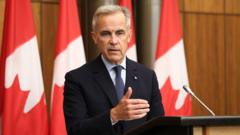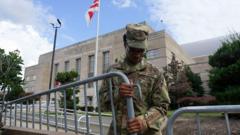The US-Mexico border wall will be painted black as part of a strategic move to deter illegal crossings, with the initiative credited to former President Donald Trump. A significant budget has been allocated for construction alongside promises of increased border security measures.**
New Black Finish on US-Mexico Border Wall Aimed at Deterring Climbers**

New Black Finish on US-Mexico Border Wall Aimed at Deterring Climbers**
Homeland Security plans to paint the border wall black to increase its heat and climbing difficulty, alongside additional construction projects.**
The United States is set to take a controversial step in its immigration policy by painting the entire US-Mexico border wall black, a move believed to make it more challenging for climbers to scale. Homeland Security Secretary Kristi Noem, in a statement, revealed the decision was directly inspired by former President Donald Trump, emphasizing the black paint's heat-retaining properties in the sweltering Texan climate.
This initiative is part of an overall immigration crackdown that has seen funding up to $46 million allocated for new wall construction as part of Trump's spending bill. With construction currently progressing at a remarkable rate of half a mile (0.8km) daily across the nearly 2,000-mile (3,218 km) border, the administration asserts that this new measure will further deter undocumented crossings.
Noem noted during her visit to New Mexico that the dark color would not only increase temperatures along the wall but would also serve as a deterrent against rusting, thereby extending the lifespan of the structure. This approach accompanies additional plans for "waterborne infrastructure" along the Rio Grande, a significant portion of the border, which Texas authorities have previously fortified with floating barriers and enhanced riverbank fencing.
The reduction in border crossings has been stark; under Trump's administration, detentions have dipped to historic lows, with only approximately 4,600 incidents recorded in July—a staggering 92% drop compared to the previous year. While the administration celebrates this decline, immigration advocates have raised concerns about the impact of mass deportations, arguing that many individuals without criminal backgrounds have been swept up in enforcement actions.
In a broader context, the administration claims that increased security measures, alongside deportation agreements with countries like Honduras and Uganda, are key components in curtailing illegal migration. However, the debate continues regarding the balance between security and human rights, as well as the actual effectiveness of these deterrents on the ground.























